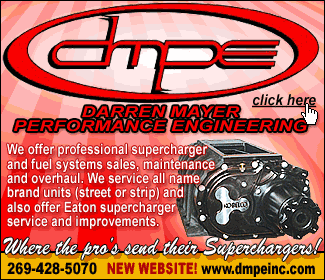
After waiting some time, out of respect, Johnson contacted one of Jenning's daughters about buying the Bird. Yes, the car was for sale--but only to the right person. Johnson had to pass a family "interview" to determine if he qualified. Other potential buyers had
ADVERTISEMENT
 |
revealed their intentions of putting the car back to its original 4-speed stock configuration to make it a correct, super low mileage, B5 blue Hemi SuperBird (you know what those cars are selling for!) That's the last thing the family wanted to happen. Johnson assured his interviewers that he would keep the car as raced by Jennings. He passed the test and the family sold him the car in June '05. The Bird made its public debut at this year's Nats as part of the Road Runner special display, where, for a car that had limited previous exposure, it received an enormous amount of attention. Except for new sparkplugs and an oil change, it is essentially the same now as when it came out of Jenning's shop.
Johnson, who has talked with Werst extensively about the car, has gone over the Bird with a fine-tooth comb. The race shop modifications he found are amazing, revealing what the engineers got away with. None of this stuff is visible--until you compare it side-by-side to a stock SuperBird, and some of it is pretty radical.
 First off, the rear axle is moved forward 2-1/2 inches, and the wheel well is opened up. Why isn't it obvious? Hamerly's job, as the painter, was to use colors and create patterns that would distract the eye from the alterations. Obviously, he was successful. The engine is moved back 2 in. The right front wheel is moved 1-1/2 forward of the front left, for a big advantage in the staging beams. The fenders and hood are lightweight metal (not acid-dipped). The rear glass is thicker and heavier than stock, and the filler panel around the glass is weighted. Also weighted is the upper center tail panel, and there's additional weight behind the tail lamps. The wing supports are pot metal, but the top of the wing is heavier than stock. A 1-1/2-in. thick sheet of lead, hidden underneath the rear package tray, runs the width of the car. Other mods that probably were legal, included a Prestolite transistor ignition up in the nose of the car, and an auxiliary electric fuel pump inside the frame above the left rear wheel.
First off, the rear axle is moved forward 2-1/2 inches, and the wheel well is opened up. Why isn't it obvious? Hamerly's job, as the painter, was to use colors and create patterns that would distract the eye from the alterations. Obviously, he was successful. The engine is moved back 2 in. The right front wheel is moved 1-1/2 forward of the front left, for a big advantage in the staging beams. The fenders and hood are lightweight metal (not acid-dipped). The rear glass is thicker and heavier than stock, and the filler panel around the glass is weighted. Also weighted is the upper center tail panel, and there's additional weight behind the tail lamps. The wing supports are pot metal, but the top of the wing is heavier than stock. A 1-1/2-in. thick sheet of lead, hidden underneath the rear package tray, runs the width of the car. Other mods that probably were legal, included a Prestolite transistor ignition up in the nose of the car, and an auxiliary electric fuel pump inside the frame above the left rear wheel.
It's amazing to think of with all the expense and effort that went into this one-of-two factory drag SuperBirds, the car's mission was Not to win, but just eliminate one man: Ray Allen. And, as it turned out, Ray ended up eliminating himself. 

